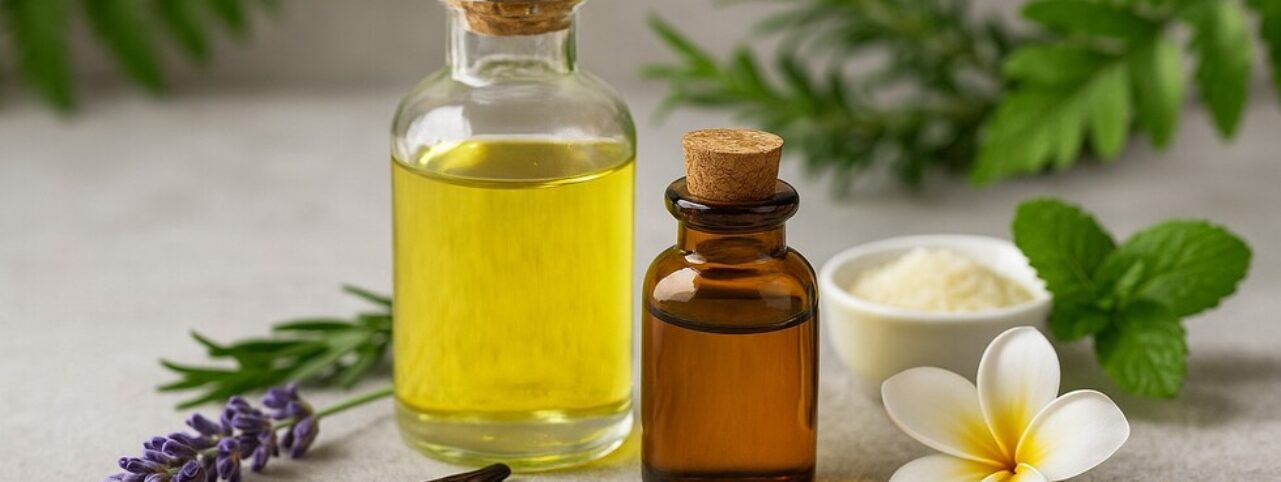Error: Contact form not found.

Aromatic compounds have long played a vital role in various industries—from perfumery and cosmetics to food and pharmaceuticals. These compounds are responsible for the scents we associate with flowers, fruits, spices, and even clean laundry. But as consumer awareness grows, so does the debate: Should we choose natural or synthetic aromatic compounds?
In this blog, we’ll break down what these compounds are, how they differ, and the pros and cons of using natural vs. synthetic aromatic compounds. Whether you’re a product developer, wellness enthusiast, or eco-conscious buyer, understanding this difference will help you make more informed decisions.
Aromatic compounds are organic molecules known for their distinct odors. At a chemical level, they often contain one or more benzene rings, making them stable and versatile. They’re used extensively in:
These aromatic compounds can be naturally derived from plants or synthesized in laboratories.
Natural aromatic compounds are obtained directly from natural sources—plants, flowers, herbs, fruits, and even resins. Common extraction methods include:
These substances retain their chemical integrity and natural complexity, often containing hundreds of compounds in one extract.
Synthetic aromatic compounds are human-made substances produced through chemical synthesis. While some synthetics are nature-identical (chemically similar to compounds found in nature), others are completely artificial, designed to mimic natural scents or create new ones.
They’re often created for consistency, cost-effectiveness, and availability—especially when natural sourcing is expensive or unsustainable.
Natural compounds are often associated with clean beauty and green living. Many people believe they are safer, less irritating, and better for sensitive skin.
Many essential oils and extracts offer additional therapeutic properties such as antimicrobial, anti-inflammatory, or stress-relieving effects. For example, eucalyptus oil helps with respiratory issues.
Natural extracts often contain hundreds of components, giving them a layered, complex aroma profile. This richness is difficult to replicate synthetically.
When responsibly sourced, natural compounds can support local agriculture and promote biodiversity.
Extracting natural oils is expensive, requiring large amounts of raw material. For instance, it takes thousands of rose petals to make just a few milliliters of rose oil.
Natural products can vary based on growing conditions, harvest time, and geography, which may affect product consistency.
Just because something is natural doesn’t mean it’s non-allergenic. Essential oils like tea tree, citrus, or cinnamon can cause skin reactions in sensitive individuals.
High demand for natural ingredients like sandalwood or agarwood has led to overharvesting, endangering plant species and affecting ecosystems.
Synthetics are generally much cheaper to produce than natural extracts, making them ideal for mass-market products.
Lab-created aromas are highly consistent—ideal for brands that require uniform product quality across batches.
They reduce pressure on natural resources and endangered plant species. For example, synthetic musk avoids the ethical issues of animal-based musks.
Synthetics allow perfumers and chemists to create entirely new scents that may not exist in nature. This expands creative and functional possibilities.
Some synthetic compounds have been linked to endocrine disruption, allergies, or headaches, especially when used in closed environments or aerosol products.
Unlike natural essential oils, synthetics usually lack additional health benefits. They are primarily valued for their scent only.
Synthetics are often petrochemical-derived, raising concerns about their environmental footprint and long-term sustainability.
In the era of clean and conscious beauty, many consumers are wary of synthetic ingredients, preferring “natural” labels—even if synthetics are technically safer or more sustainable.
| Application | Natural Compounds | Synthetic Compounds |
|---|---|---|
| Luxury Perfume | Preferred for complexity | Used for unique accords |
| Daily Skincare | Gentle and multi-functional | Affordable and stable |
| Aromatherapy | Ideal due to therapeutic value | Not used |
| Candles/Air Fresheners | May burn unevenly or fade | Long-lasting, affordable |
| Food Flavoring | Preferred in organic products | Common in processed foods |
Interestingly, many high-end brands today use a hybrid approach—combining natural extracts with synthetic counterparts to achieve:
Stability and safety
Sustainability
Signature scent profiles
Cost-effectiveness
This allows for balance between authenticity and innovation.
There is no one-size-fits-all answer in the debate between natural and synthetic aromatic compounds. Each has its place depending on the intended use, safety requirements, budget, and ethical concerns.
If you value therapeutic benefits and holistic wellness, natural oils and extracts might be your go-to. If you need reliable, long-lasting fragrance on a budget, synthetic aromatics might serve you better.
Whatever your choice, transparency in sourcing and ingredient labeling remains key. As the industry evolves, the future likely lies in eco-conscious, scientifically backed formulations—blending the best of both worlds.